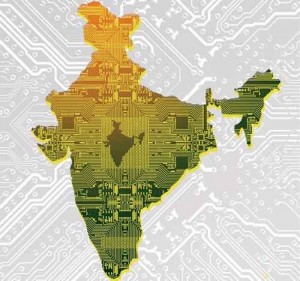 By 2020 the demand for electronic goods in India is expected to breach the US$400 billion mark, with the import bill estimated to set the country back by US$300 billion. In fact, it is expected to trump the energy import bill. India is staring at an import nightmare of unprecedented proportions that can push the country into a spiral of high imports that would necessarily require higher external and internal borrowings. There are several South American economies that have gone down that route for us to learn our lessons and not implode.
By 2020 the demand for electronic goods in India is expected to breach the US$400 billion mark, with the import bill estimated to set the country back by US$300 billion. In fact, it is expected to trump the energy import bill. India is staring at an import nightmare of unprecedented proportions that can push the country into a spiral of high imports that would necessarily require higher external and internal borrowings. There are several South American economies that have gone down that route for us to learn our lessons and not implode.
The National Policy on Electronics (NPE) 2012 is primarily aimed at ramping up India’s Electronic Design and Manufacturing (ESDM) capability. It is by far the most comprehensive policy intervention in post-independent India to boost indigenous production of semiconductor components and chips. The policy comes on the back of a strong and sustained demand for consumer electronic goods that accounted for a hefty bill of US$125 billion last year.
However, just about 10 percent of India’s consumption was produced internally; the rest was imported. In the last two decades China has become the second largest manufacturer of electronics goods in the world with its sales revenues crossing US$840 billion in 2013. This development must necessarily be seen in the context of China having overtaken the US in 2010 to become the world’s dominant manufacturing economy. China literally beat its competitors in world manufacturing, notching up US$2.9 trillion in output in 2013. In contrast, the US generated US$2.43 trillion. The Indian sales revenues for the year 2012 stood at slightly above US $68 billion, less than even one-tenth the size of the Chinese juggernaut.

“Combined with the accelerated rate at which the Indian economy is growing, has resulted in a respective increase in the demand for semiconductors, which for Infineon presents a more than welcome challenge.”
Vinay Shenoy, Managing Director, Infineon Technologies India
Infineon,global semiconductor innovation leader in energy efficiency, mobility and security, employs around 375 professionals in India. Infineon’s business spans from automotive electronics semiconductor solutions for powertrain, safety in two and four-wheel vehicles, chip card and security solutions for ePassport, citizen cards and drivers’ licences to industrial and multi-market sector solutions for electronic ballast, power supplies, solar and wind energy conversion. Originally set up in Bangalore, India, in 1997 under the name of Siemens Semiconductor India Private Limited, the company took on the current name, Infineon Technologies India Private Limited in 1999, following the global spin-off from Siemens AG.
While local market and business development are increasingly important, Infineon India is already a well-established major centre within Infineon’s global R&D network and plays an essential role in software and hardware development for global products. Software development projects involve all layers from low-level software design to high-level application software and complex configuration software, whereas hardware design involves complex system-on-chip development and testing, technology drivers (test chips and design packages), design automation systems (design flow and design libraries). The company’s annual investments in R&D and the development of the India market currently total over ten million euro.Infineon India’s main incentive for setting up operations in India was the country’s abundance of highly skilled professionals in the areas of hardware and software development and R&D. This is now supplemented by the company’s attraction to the Indian semiconductor market. According to industry analysts, India’s markets for automotive and industrial electronics and smart cards are estimated to reach two billion US dollars by 2015.Existing engineering activities will be expanded further by initiating a new competence centre for power electronics.
Semiconductor technology and the manufactured “chip“ products form an integral part of everyday life and without them, productivity, convenience and safety would not have been possible in modern society. This need, combined with the accelerated rate at which the Indian economy is growing, has resulted in a respective increase in the demand for semiconductors, which for Infineon presents a more than welcome challenge.
Infineon India is committed to Corporate Social Responsibility (CSR) and has launched several initiatives to ensure that it plays a significant role in contributing to Indian society. One such initiative is its contribution to the development of primary education by supporting local rural schools at which many of the company’s employees have also taught in the past, helping teachers to offer the best possible education to children from poorer backgrounds as well as providing uniforms and midday meals.

“Developing Electronics Ecosystem in India is a challenge; but not impossible”
Mr. Umesh Anandani, Additional Secretary, ELCINA India
Foreign investment is very important for India and it will bring exponential growth to the Indian electronics market. Foreign companies can invest in India, either on their own or as a joint venture. 100% FDI is allowed under the automatic route in ESDM sector. However, in case of defence electronics items, FDI up to 26% is allowed under the government approval route and above 26% is allowed through approval of cabinet committee on security (This is allowed on case to case basis; investments should ensure access to modern and ‘state-of-art’ technology in the country).
Developing Electronics Ecosystem in India is a challenge; but not impossible! It is high time that we look at this situation in a positive light, challenge our circumstances and take a closer look at what is already going on in the country and strengthen the hands of our entrepreneurs by ceaselessly striving to create new opportunities in the Electronics Sector. The National Policy for Electronics (NPE) has clearly paved the way for progress and it is no small achievement that applications worth more than Rs. 15,000 Crores have been received for investments under the M-SIPS Scheme (Modified Special Incentive Package Scheme) and further a whopping Rs 50,000 Crores is committed for the two Semiconductor Fabs recently announced by the Government of India. A quiet awakening and ESDM revolution is underway in India!
In addition to the Policy & eco-system, there is wide acceptance at all levels of government that Electronics manufacturing is a vital issue today. If we ignore and delay the development of this sector, we will be caught in a vicious cycle of imports and deficits. The Indian Rupee has depreciated enough to incentivize exports and make imported finished goods and raw materials more costly. The Indian market continues to expand at a rapid and steady pace giving us the consolation of a sustained demand which all industry hopes and prays for! While economic growth has slowed down, the spread of electronics in all walks of life is so comprehensive, that its demand keeps growing … The list of electronic products & gadgets is unending, LED Lights, Tablets, Laptops, Set Top Boxes, 4G Televisions & Mobiles, Gaming & Internet equipment, Toys, Multimedia Entertainment, Medical Devices you name it and it’s available!
ELCINA believes that the government and the industry need to work together to stimulate manufacturing and catalyze an IT/Electronics boom that can contribute significantly to the development of India. ELCINA persistently works to facilitate changes that would strengthen India’s electronics and IT manufacturing base to make it a leader on the world electronics map. Electronics Manufacturing Clusters Scheme aims at providing world-class infrastructure for attracting investments in the ESDM sector. The scheme offers financial support for the development of Electronics Manufacturing Clusters (EMCs) as these EMCs would aid the growth of the ESDM sector, development of entrepreneurial ecosystem, and drive innovation.
We have looked at disabilities in electronics manufacturing long enough and now we must look at our inherent abilities. The only way to succeed is by first bringing to completion that which is most important. We must be self-reliant and manufacture what we can while continuing to expand the range of products and technologies that we can comprehend and increase our manufacturing base. As we understand, what is feasible in India, we must invest in eco-systems to enhance capacities, lower costs and capture domestic and global markets. A significant presence in a few important electronics verticals is vital for an all important ripple effect to take place in the industry and grow exponentially.






